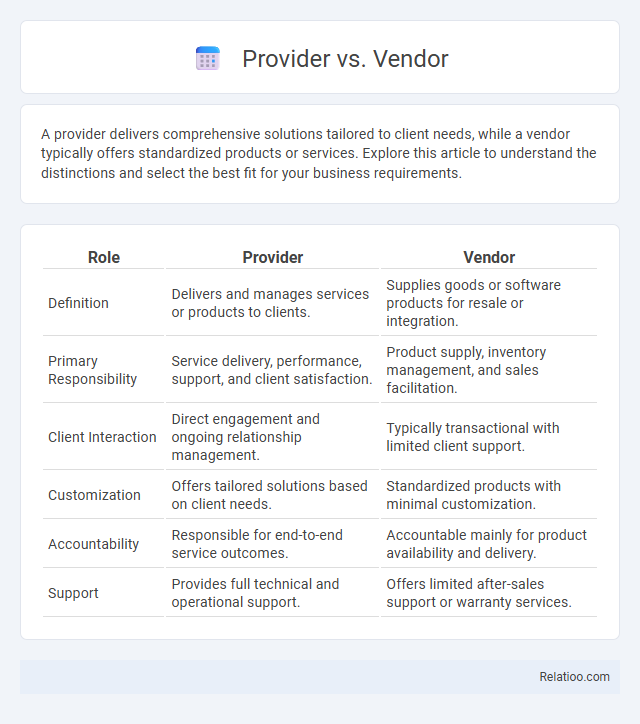A provider delivers comprehensive solutions tailored to client needs, while a vendor typically offers standardized products or services. Explore this article to understand the distinctions and select the best fit for your business requirements.
Table of Comparison
| Role | Provider | Vendor |
|---|---|---|
| Definition | Delivers and manages services or products to clients. | Supplies goods or software products for resale or integration. |
| Primary Responsibility | Service delivery, performance, support, and client satisfaction. | Product supply, inventory management, and sales facilitation. |
| Client Interaction | Direct engagement and ongoing relationship management. | Typically transactional with limited client support. |
| Customization | Offers tailored solutions based on client needs. | Standardized products with minimal customization. |
| Accountability | Responsible for end-to-end service outcomes. | Accountable mainly for product availability and delivery. |
| Support | Provides full technical and operational support. | Offers limited after-sales support or warranty services. |
Introduction: Understanding Providers and Vendors
Providers and vendors play distinct roles in the supply chain and service delivery ecosystem. A provider offers comprehensive services or solutions tailored to your specific needs, while a vendor supplies products or goods, often in bulk or standard form. Understanding these differences helps you make informed decisions when selecting partners for your business or personal requirements.
Defining Providers and Vendors
Providers deliver services or products directly to customers, acting as the primary source in the supply chain. Vendors are entities that sell goods or services but often source these from providers or manufacturers. Understanding the distinction between providers and vendors clarifies roles in procurement, supply chain management, and service delivery processes.
Key Differences Between Providers and Vendors
A provider delivers specific services or solutions directly to You, often including ongoing support or management, while a vendor primarily supplies products or goods without ongoing service commitments. Providers typically engage in long-term relationships and customized offerings, whereas vendors focus on transactional sales of standardized items. Understanding this distinction helps You select the right partner based on whether continuous service or one-time product delivery is essential for Your business needs.
Roles and Responsibilities
A provider primarily delivers products or services directly to clients, ensuring quality and customer satisfaction. A vendor typically sells goods or services to businesses, focusing on supply chain efficiency and transactional processes. Your understanding of these distinct roles helps optimize procurement strategies and vendor management practices.
Service Delivery Models
Service Delivery Models differentiate between providers and vendors based on their roles in delivering solutions; providers offer comprehensive, end-to-end services tailored to Your specific needs, while vendors supply individual products or components within those services. Providers focus on ongoing management, support, and integration, ensuring seamless service delivery and customer satisfaction. Vendors typically operate on a transactional basis, supplying goods or software without the extended responsibility for implementation or support.
Benefits of Choosing a Provider
Choosing a provider offers streamlined access to specialized services and tailored solutions that align with your specific needs. Providers often deliver consistent support and maintain a deeper understanding of industry standards, ensuring high-quality outcomes. Your business benefits from enhanced reliability and a collaborative partnership that fosters long-term growth.
Advantages of Working With a Vendor
Working with a vendor offers advantages such as streamlined procurement processes, access to specialized products or services, and competitive pricing due to established supply chains. Vendors often provide dedicated customer support and flexible contract terms, enhancing project efficiency and reducing operational risks. Leveraging a vendor's expertise and inventory can lead to faster delivery times and improved overall business scalability.
How to Choose: Provider vs Vendor
Choosing between a provider and a vendor depends on the scope and nature of the services or products required. Providers typically deliver comprehensive solutions, including ongoing support and customization, making them ideal for long-term partnerships and complex needs. Vendors generally supply specific products or components without extensive service, suitable for straightforward transactions or one-time purchases.
Common Misconceptions
Common misconceptions often arise between providers, vendors, and suppliers due to overlapping roles in delivering goods and services. Providers typically offer comprehensive solutions or ongoing services, while vendors focus on selling specific products, and suppliers supply raw materials or components. Understanding these distinctions helps you clarify responsibilities and streamline procurement strategies in business operations.
Conclusion: Making the Right Choice
Choosing between a provider, vendor, or supplier depends on your specific business needs and the scope of services required. Providers typically offer comprehensive, ongoing services, vendors supply specific goods or products, and suppliers focus on the procurement and delivery process. By evaluating Your project demands, cost efficiency, and desired level of support, you can make the right choice to optimize operational success.

Infographic: Provider vs Vendor
 relatioo.com
relatioo.com